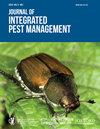谷子重要经济害虫的管理
IF 2.7
3区 农林科学
Q1 ENTOMOLOGY
引用次数: 11
摘要
小米是撒哈拉以南非洲、印度次大陆和中国农村社区的主食。此外,小米在美国被用作家禽和牛的饲料,其叶子在印度是牛的饲料。这种作物在生长发育过程中受到至少150种害虫的危害。虽然所有这些害虫的现状尚不清楚,但苍蝇、茎螟虫、吸叶昆虫和攻击穗的昆虫被认为具有重要的经济意义。控制措施包括使用合成农药(种子处理和叶面施用)和栽培方法(种植时间和田间卫生)。寄主植物抗性(基因型筛选和耐/抗性品种选育)和生物防治(天敌保护和拟寄主habrobrabon hebetor幼虫的定期释放)是近年来备受关注的问题。建议综合现有的虫害防治办法,同时让资源贫乏的小农进一步采用新的作物种植技术。本文章由计算机程序翻译,如有差异,请以英文原文为准。
Management of Economically Important Insect Pests of Millet
Grain of various species of millet is a staple food of rural communities in sub-Saharan Africa, the Indian subcontinent, and China. In addition, millet is used as poultry and cattle feed in the United States, and the foliage is fodder for cattle in India. The crop is damaged by at least 150 insect pests during its growth and development. Although the current status of all of these pests is not known, shoot flies, stem borers, leaf-sucking, and the panicle-attacking insects are considered economically important. Control measures include the application of synthetic pesticides (as both seed treatment and foliar applications) and cultural methods (timing of planting and field sanitation). Host plant resistance (screening of genotypes and breeding of pest-tolerant/resistant cultivars), and biological control (conservation of natural enemies and periodical releases of the larval parasitoid Habrobracon hebetor) have received much attention in recent years. Integrating available pest control options has been recommended, along with further adoption of new crop cultivation technologies by small and resource-poor farmers.
求助全文
通过发布文献求助,成功后即可免费获取论文全文。
去求助
来源期刊

Journal of Integrated Pest Management
Agricultural and Biological Sciences-Insect Science
CiteScore
5.80
自引率
3.60%
发文量
24
审稿时长
25 weeks
期刊介绍:
Journal of Integrated Pest Management is an open access, peer-reviewed, extension journal covering the field of integrated pest management. The Editors-in-Chief are Dr. Marlin E. Rice (formerly with Iowa State University) and Dr. Kevin L. Steffey (formerly with the University of Illinois). The journal is multi-disciplinary in scope, publishing articles in all pest management disciplines, including entomology, nematology, plant pathology, weed science, and other subject areas.
 求助内容:
求助内容: 应助结果提醒方式:
应助结果提醒方式:


